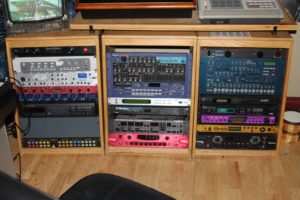Digital To Analog Converters
DACs are an important part of our signal chain. They take our digital data and convert it to analog, so we can hear it. It is the final box in the digital chain and its quality level is critical to the sound you are trying to create. If your work is headed to the professional mastering stage, then they will be using expensive DACs for mastering. There are quality differences among DACs and one must choose a DAC that adds to the sonic qualities one is after in your mix. There are five major areas one must consider when choosing a DAC: tonal balance, separation, low level detail, image and separation along with musicality.
Tonal Balance
There is a difference among converters when it comes to the balance of tones. It will not be as great as a difference as with microphones but it will be there. Some converters may sound more “warm” when compared to others. There can be converters that sound brighter than others. You can tell those right away and one must be careful in choosing a converter that does sound bright. Digital can be bright by definition, we surely do not want to add any more brightness through our convertor choice. Specs will not tell you this, you must listen to each DAC in your signal chain to discover this for yourself.
Separation
A quality DAC must have good separation of all vocals and instruments. It must be able to allow all of the details of both to come through. Lower quality DACs will not have this ability and it is probably the most important characteristic to have in your DAC. Low frequency notes must be clear and defined and not smother or blur middle frequency instruments or vocals. High frequencies should be clear and distinct and not be covered up by any middle frequency “soup”.
Low Level Detail
Low level detail is an area where a good quality DAC will really shine. Major differences among DACS are usually found in a unit’s ability to resolve harmonics and reverberation trails. If your reverberation trails sound choppy instead of smooth, the DAC is struggling with low level detail. Attack and decay of instruments needs a high resolution and a lot of DACs are missing in this area.
Imaging
The image or sound stage our converters display will translate through to our speakers and then into our room. Stay away from converters that have a “flat” sound where all the instruments and vocals are smashed together like on a computer screen. We do not want a large flat wall of sound but rather a sound stage that has separation between each instrument and vocal and they are all positioned on the stage with some depth to them. The sound stage should also be wide and not narrow and focused.
Musicality
This is the most difficult characteristic to quantify but probably the most important. Does it sound musical and not processed? We want to forget that this is a piece of electronic equipment and its job is to get out of the way and let the music shine through. A musical DAC will jump right out at you when you are comparing it to one that is not so musical. The unit must sonically disappear and thus allow for the music to come through. This is the most important quality a DAC can exhibit.
Source Quality
How does one evaluate a DAC and ensure that all the evaluation criteria can be realized. Lets set some ground rules at the beginning of our evaluation process to insure some type of objectivity and true meaning. Lets first choose a very high quality source as our start point. We should start with three high quality sources to really test the DAC’s performance abilities. Master tapes are the best start source I can think of. DSD sourced SACDs are another good quality beginning and then we could also use a mixed source from Radar. Sources that have not been digitized are the best beginnings.
Calibration
Of all the evaluation criteria, calibration is the most important. We want to make sure any comparisons between units is done at the same decibel. We all know that even a 1/10 difference in this area can have a noticeable impact.Use a test tone and adjust the meters to make sure all comparisons are done at the same level. We want to make sure we are not introducing any of our own personal “distortions” into the comparison.
Internal Clocks
All converters have internal clocks. We want to make sure that we run all converters on their internal clocks. This is the way the unit was designed to work and it should be able to exhibit its sonic signature using its own clock. If you have an external clock, it would be interesting to use it instead of the internal clock and compare the results you hear. Since most of us must rely on the units own clock, we should use that one for comparison purposes.
Same Volume Levels
We must listen at the same volume level. Louder is not better as we all know but sometimes do not practice. It must be practiced in this evaluation or our results are meaningless. Choose a comfortable volume level that will not lead to listener fatigue or excite that room modal issue you have not had time to get to. Leave the volume knob alone and keep all gain the same for each unit you are evaluating.
Head Positioning
Make sure your head is positioned in the same place for each DAC evaluation. This sounds weird but it is important. We are trying to listen for minute details in instrument and vocal separation, imaging, and detail. Any change in head position will affect this critical listening and evaluation process. Near field monitoring is best for this step in the evaluation process. We want to take as much room sound out of the equation as possible.
Blindfold Necessary
All listening tests must be done blindly. You must not be able to know the manufacturer of the unit. We do not any perception or marketing bias to enter into the equation. There should be no perceived value towards this unit or that unit based on the manufacturer. Harman International is famous for its double blind listening tests when it comes to speakers. One should study their approach to evaluating speakers and use this same methodology in evaluating DACs.
First Impressions
Record all your first impressions for each unit that you are listening to. Use whatever words that you are familiar with to tell yourself later what you initially heard. Use descriptive words that you use to describe sound qualities that you consider important. Bright, hard, smeared, and blurred come to mind for me.
Personal Preference
Ultimately, the choice of a converter is a very personal one, just like choosing mics or speakers. Although it’s not the most sonically significant item in the recording chain, if you’re recording to digital, everything you record will have that sonic imprint on it. So it’s a critical component. Listen carefully and pick the one that best preserves all your engineering craftsmanship.
In Summary
I hope this explanation helped. Please leave any comments below so I can get back to you. Don’t be afraid to hit those Facebook like, Google+ and Twitter buttons on the left hand side so other people can see this post. And if you want to learn more about this subject please sign up for our free room acoustic treatment videos and ebook which provide step by step instructions. Get instant access by signing up now.
Thanks
Mike








I constantly spent my half an hour to read this website’s content daily along with a
cup of coffee.
Hi Bester,
Thanks. I try to keep it interesting and simple. Its nice to hear you enjoy our content.
Dennis
So is there an unbiased list of quality rankings? I’ve got an Oppo 105D and I was going to build a NAS and pump the music through it rather than having yet another component in my system. To do some of the steps you state, I would have to take my digital music to a retailer and conduct my blindfolded test (which I did with my speakers). However the selection of DAC’s is not that great. Thanks for the article, every little bit helps with my education.
Hi Gary, From the current quality and price points of DACs, you have to spend around 2,000 to get something of good quality. There are incremental increases in quality after that but the price point goes much higher.